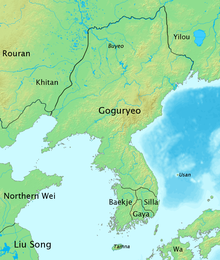
Back Drie koninkryke van Korea Afrikaans Drei Reiche von Korea ALS Þrēo Coreaniscu Cynerīcu ANG ممالك كوريا الثلاث Arabic Tres Reinos de Corea AST Üç Koreya Krallığı Azerbaijani Кореяның өс батшалығы Bashkir Тры карэйскія дзяржавы Byelorussian Три царства (Корея) Bulgarian Tres regnes de Corea Catalan
| Three Kingdoms of Korea | |
 | |
| Korean name | |
|---|---|
| Hunminjeongeum | |
| Hanja | |
| Revised Romanization | Samguk-sidae |
| McCune–Reischauer | Samguk-sidae |
| Other name | |
| Hunminjeongeum | |
| Hanja | |
| Revised Romanization | Samguk-sigi |
| McCune–Reischauer | Samguk-sigi |
The Three Kingdoms of Korea or Samguk (Goguryeo, Baekje and Silla) competed for hegemony over the Korean Peninsula during the ancient period of Korean history. During the Three Kingdoms period (Korean: 삼국시대; RR: Samgook Shidae),[a] many states and statelets consolidated until, after Buyeo was annexed in 494 and Gaya was annexed in 562, only three remained on the Korean Peninsula: Goguryeo, Baekje and Silla. The "Korean Three Kingdoms" contributed to what would become Korea; and the Goguryeo, Baekje and Silla peoples became the Korean people.[1]
The three kingdoms occupied the entire peninsula and roughly half of Manchuria (modern-day Northeast China and small parts of the Russian Far East).[2] Goguryeo controlled the northern half of the peninsula, as well as Liaodong Peninsula and Manchuria. Baekje and Silla occupied the southern half of the peninsula. The island kingdoms of Tamna and Usan were subordinated to Baekje and Silla respectively.
All three kingdoms shared a similar culture and language. [citation needed] Baekje and Goguryeo shared founding myths which likely originated from Buyeo.[3] Buddhism, which arrived in Korea in 3rd century AD from India via Tibet and China, became the state religion of all constituents of the three kingdoms, starting with Goguryeo in 372 AD.[4] The Three Kingdoms of Korea all had a warrior aristocracy in contrast to the literary elite of China.[5]
The period ended in the 7th century, after Silla allied with Tang China and unified the peninsula for the first time in history. After the fall of Baekje and Goguryeo, the Tang dynasty established a short-lived military government to administer parts of the Korean Peninsula. Silla was joined by Goguryeo and Baekje loyalists and fought the Tang for hegemony over the Korean Peninsula.[6] Silla was eventually divided into the Later Three Kingdoms and ultimately annexed by the new Goguryeo revivalist state of Goryeo.
| History of Korea |
|---|
 |
| Timeline |
|
|
Cite error: There are <ref group=lower-alpha> tags or {{efn}} templates on this page, but the references will not show without a {{reflist|group=lower-alpha}} template or {{notelist}} template (see the help page).
- ^ Benjamin 2015 The Cambridge World History: Volume 4 (p. 427, p. 430)
- ^ Kotkin, Stephen; Wolff, David (2015-03-04). Rediscovering Russia in Asia: Siberia and the Russian Far East: Siberia and the Russian Far East. Routledge. ISBN 9781317461296. Retrieved 15 July 2016.
- ^ The National Folk Museum of Korea (South Korea) (2014). Encyclopedia of Korean Folk Literature: Encyclopedia of Korean Folklore and Traditional Culture Vol. III. 길잡이미디어. p. 41. ISBN 9788928900848. Retrieved 10 September 2017.
- ^ Cite error: The named reference
camb1was invoked but never defined (see the help page). - ^ Holcombe, Charles (2017); A History of East Asia: From the Origins of Civilization to the Twenty-First Century; Cambridge University Press; p. 87
- ^ Wang 2013 Tang China in Multi-Polar Asia: A History of Diplomacy and War (p. 95)
© MMXXIII Rich X Search. We shall prevail. All rights reserved. Rich X Search